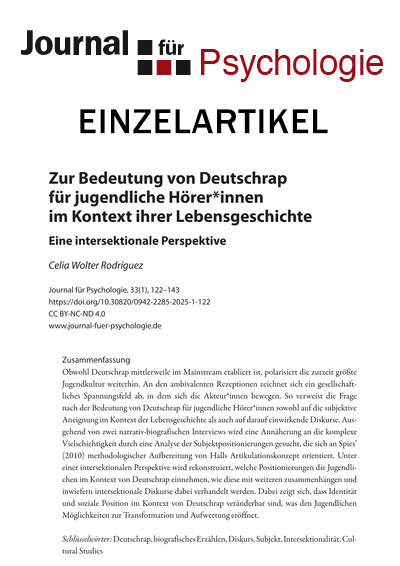The meaning of German rap for young listeners in the context of their life stories
An intersectional perspective
DOI:
https://doi.org/10.30820/0942-2285-2025-1-122Keywords:
German rap, biographical narration, discourse, subject, intersectionality, cultural studiesAbstract
Although German rap is now established in the mainstream, what is currently the biggest youth culture, it continues to polarise. The ambivalent receptions reveal a social field of tension in which the protagonists operate. The question of the significance of German rap for young listeners refers to both the subjective appropriation in the context of life history and the discourses that influence it. Based on two narrative-biographical interviews, an approach to the complex multi-layeredness is sought by analysing the subject positionings, which is oriented towards Spies’ (2010) methodological adaptation of Hall’s concept of articulation. An intersectional perspective is used to reconstruct the positionings of the young people in the context of German rap, how these are related to others and to what extent intersectional discourses are negotiated in the process. This shows that identity and social position can be changed in the context of German rap, offering young people opportunities for transformation and valorisation.
Downloads
How to Cite
Wolter Rodríguez, Celia. 2025. “The Meaning of German Rap for Young Listeners in the Context of Their Life Stories: An Intersectional Perspective”. Journal für Psychologie 33 (1):122-43. https://doi.org/10.30820/0942-2285-2025-1-122.
Issue
Section
Artikel
License

This work is licensed under a Creative Commons Attribution-NonCommercial-NoDerivatives 4.0 International License.
This license allows private use and unmodified distribution, but prohibits editing and commercial use (further information can be found at: https://creativecommons.org/licenses/by-nc-nd/4.0/).
The terms of the Creative Commons licence only apply to the original material. The reuse of material from other sources (marked with a reference) such as charts, illustrations, photos and text extracts may require further permission for use from the respective copyrights holder.


